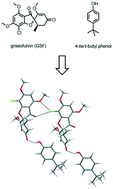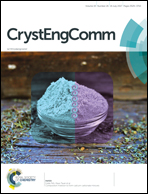Cocrystals of spironolactone and griseofulvin based on an in silico screening method†
Abstract
Cocrystal formation is considered as one of the most effective solid-state methods to alter the physicochemical properties of active pharmaceutical ingredients (APIs). In silico methods for cocrystal prediction are mostly based on structural and energetic considerations. We have developed a computational method that ranks the probability of cocrystal formation of APIs with large databases of crystal coformers (CCFs). This approach is based on using molecular electrostatic potential surfaces to assess molecular complementarity between two cocrystal components. The screening tool was applied to two low solubility drugs, namely griseofulvin and spironolactone. Promising coformer candidates were selected from a database of 310 pharmaceutically acceptable CCFs, and experimental screening was carried out. Novel solid forms were obtained by liquid-assisted grinding and were characterised by XRPD, DSC, TGA and IR. One new cocrystal of griseofulvin and two new cocrystals of spironolactone were identified, and the crystal structures were determined from the XRPD patterns. For these systems, phenols tend to act as successful H-bond donors in forming cocrystals, while carboxylic acids only give rise to physical mixtures of the two components.



 Please wait while we load your content...
Please wait while we load your content...